Samsung Galaxy S 2 (International) Review - The Best, Redefined
by Brian Klug & Anand Lal Shimpi on September 11, 2011 11:06 AM EST- Posted in
- Smartphones
- Samsung
- Galaxy S II
- Exynos
- Mobile
GLBenchmark 2.1 Solves Our Resolution Problems
Modern Android smartphones either run at 800 x 480 (WVGA) or 960 x 540 (qHD). The iPhone 4 features a 960 x 640 (DVGA) display, while the iPad 2 has a 1024 x 768 (XGA) panel. To complete the confusion Honeycomb tablets run at 1280 x 800 (WXGA). While measuring 3D performance at native resolution is useful in determining how well games will run on a device, it's not particularly useful in comparing GPUs. Fill rate and memory bandwidth requirements increase with pixel count. Even just between Android devices, those with a qHD display have 35% more pixels to render than their WVGA counterparts.
Unfortunately not all benchmarks give us the ability to perform tests at a common resolution. To make matters worse, not all devices are even capable of running at the resolutions we'd want to test. BaseMark ES2, the rebranded 3DMarkMobile allows us to specify display resolution which we have done in previous reviews. For smartphones we standardize on 640 x 480 and for tablets it's 1024 x 768. GLBenchmark however hasn't given us the ability to do that until recently.
GLBenchmark 2.1 now includes the ability to render the test offscreen at a resolution of 1280 x 720. This is not as desirable as being able to set custom resolutions since it's a bit too high for smartphones but it's better than nothing. The content remains unchanged from GLBench 2.0, there are still two primary tests that measure overall OpenGL ES 1.0 and 2.0 performance in addition to a number of specific synthetic feature tests.
We'll start with some low level tests to give us an idea of what we're looking at. First up is a raw triangle throughput test:

GLBenchmark 2.1 made some changes to the fill rate and triangle throughput tests so these numbers aren't comparable to the 2.0 results. Although the Nexus S' single core CPU, older drivers and lower clocked GPU put it at the bottom of the list, the LG Optimus 3D is the best showing of the PowerVR SGX 540. The SGX 540 in the LG phone ends up at around half the peak triangle rate of the iPad 2, perhaps due to better drivers or a higher clock speed. Here we see the true limitations of ARM's 4:1 pixel to vertex shader architecture. The Mali-400 barely outperforms the Nexus S and offers around 1/3 of the triangle rate of the PowerVR SGX 540 in the Optimus 3D. The Adreno 220 does well here and ends up at around 2x the performance of the Mali-400.
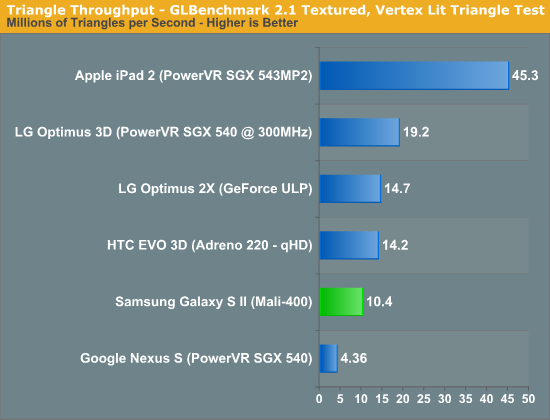
As we move to a more complex triangle test the PowerVR SGX 540 in the Optimus 3D is now only 85% faster than the Mali-400. The Nexus S' performance, despite using the same GPU, is simply abysmal. The Adreno 220 drops to only 37% faster than the Mali-400. No matter how you slice it, the 4-core Mali-400 just can't compete in geometry performance with today's GPUs. Luckily for ARM however, most mobile games aren't geometry bound - what we really need here is pixel processing power and that's something Mali-400 does deliver quite well.
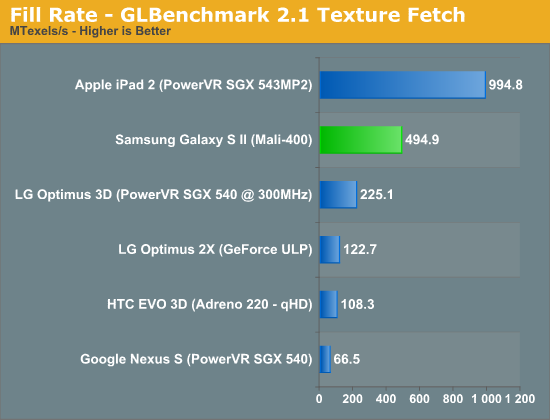
GLBenchmark 2.1's fill test paints a different picture for Mali-400. Here the SGX 540 is less than half the speed while the iPad 2's SGX 543MP2 is about twice the speed. The Mali-400's texturing performance is very solid, no GPU currently shipping in a smartphone can touch it.
What about in a game-like workload? For that we turn to the standard GLBenchmark game tests: Egypt and Pro.
GLBenchmark 2.1—as its name implies—tests OpenGL ES 2.0 performance on compatible devices. The suite includes two long benchmarking scenarios with a demanding combination of OpenGL ES 2.0 effects - texture based and direct lighting, bump, environment, and radiance mapping, soft shadows, vertex shader based skinning, level of detail support, multi-pass deferred rendering, noise textures, and ETC1 texture compression.
GLBenchmark 2.1 is the best example of an even remotely current 3D game running on this class of hardware—and even then this is a stretch. If you want an idea of how the Mali-400 stacks up to the competition however, GLBenchmark 2.1 is probably going to be our best bet (at least until we get Epic to finally release an Unreal Engine benchmark).
First let's look at the 1280 x 720 results from 2.1:
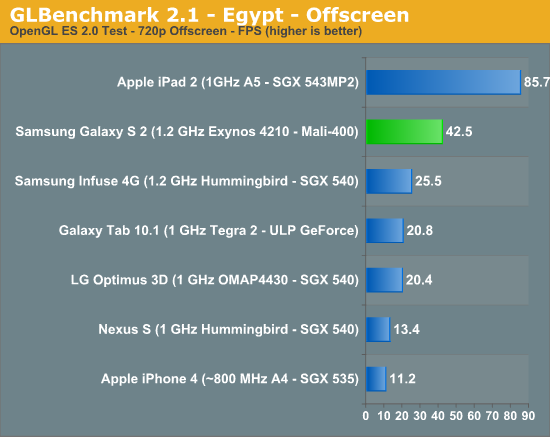
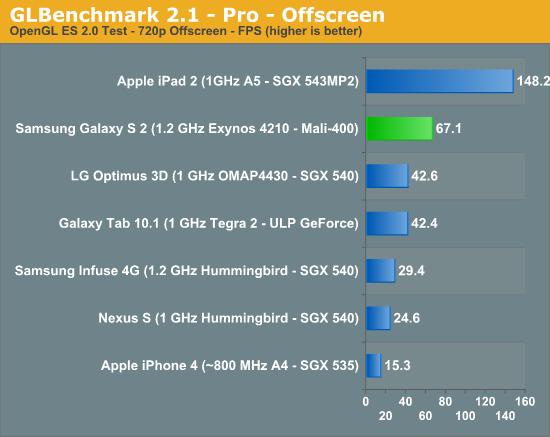
Despite huge disadvantages in geometry performance the Mali-400 does extremely well in the Egypt test, outpacing most of its competitors by a factor of 2. Only the iPad 2 is faster but that's to be expected based on the raw horsepower of its GPU. Given current workloads, ARM's Mali-400 is clearly the fastest GPU available on a smartphone today.
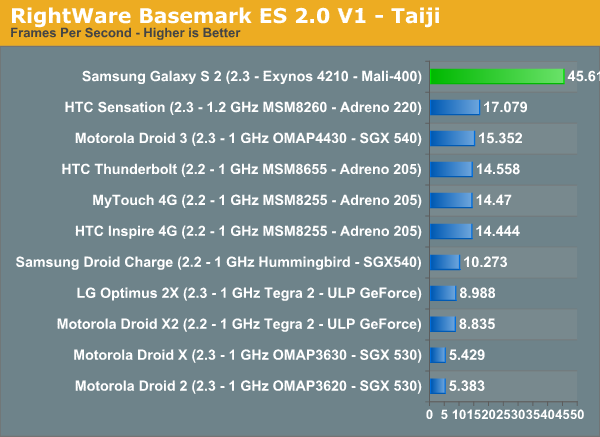
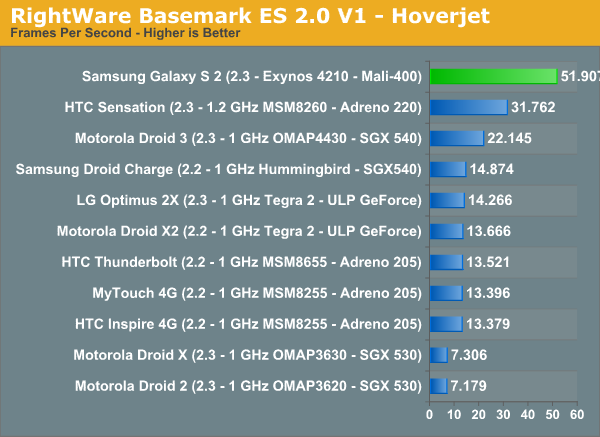
The dominance continues in the Basemark ES 2.0 tests, the Galaxy S II consistently delivers frame rates more than 2x those of its competitors. It's a shame that 3D gaming isn't a bigger deal on Android today because it'd be nice to really see ARM's high end GPU get a chance to flex its muscle on a regular basis.
For comparison to our older phones we've got our standard GLBenchmark 2.0 graphs below:
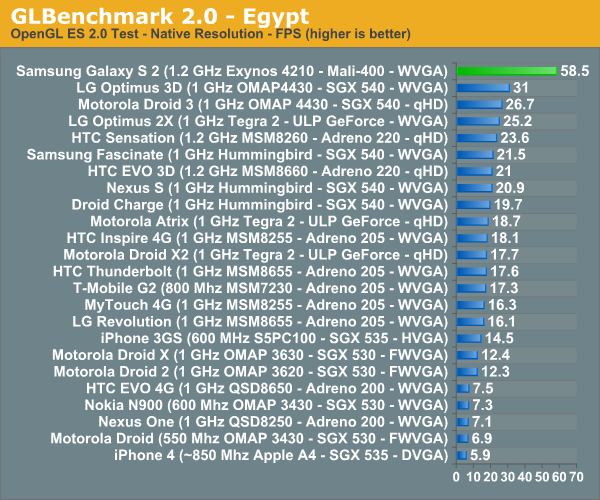

Scrolling Performance
The Galaxy S II is by far the smoothest scrolling Android device we've ever reviewed. Architecturally it has all of the right components to deliver a buttery smooth UI: gobs of memory bandwidth and a very high speed GPU. The software appears to complement it very well. Once again we turn to Qualcomm's Vellamo benchmark to quantify scrolling performance on the Galaxy S II:
| Qualcomm Vellamo Benchmark - Scrolling Performance Tests | |||||
| WVGA Unless Otherwise Noted | Ocean Flinger | Image Flinger | Text Flinger | ||
| HTC EVO 3D (Adreno 220 - qHD) | 68.98 | 26.03 | 41.79 | ||
| Motorola Photon 4G (GeForce ULP) | 62.07 | 17.64 | 35.21 | ||
| Samsung Galaxy S 4G (PowerVR SGX 540) | 55.98 | 26.27 | 31.83 | ||
| Samsung Galaxy S 2 (Mali-400 MP4) | 91.02 | 35.14 | 51.19 | ||
Vellamo produces its scores directly from frame counters, so what you're looking at is a direct representation of how fast these devices scroll through the three web tests above. The Galaxy S II is 20 - 35% faster than the Photon 4G and 45 - 100% faster than the EVO 3D. We simply have no complaints here.
Flash Performance
Thus far NVIDIA's Tegra 2 has delivered the best overall GPU accelerated Flash expierence of any SoC on the market today. With the latest update to Flash enabling NEON support on OMAP 4 both it and the Exynos 4210 now match what NVIDIA delivers here:
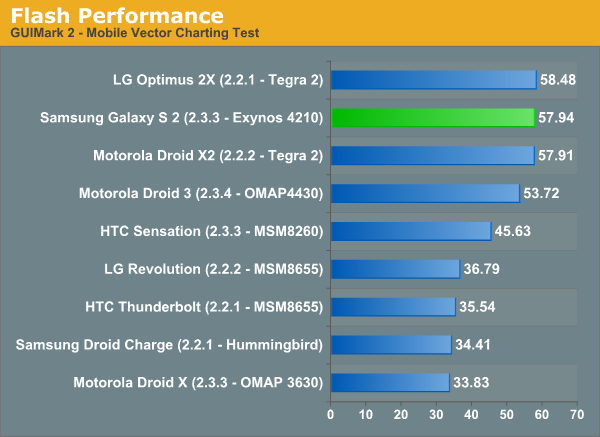
Until we hit 2012 and meet NVIDIA's Kal-El in smartphones (tablet release in 2011) and Qualcomm's first Krait designs, Samsung's Exynos 4210 looks like the best SoC for Android smartphones.










132 Comments
View All Comments
kreacher - Monday, September 12, 2011 - link
I was disappointed to see that there is no mention of the screen 's inability to display 24bit gradients while Samsung claims its a screen capable of displaying 16M colors.supercurio - Monday, September 12, 2011 - link
See my answer for Astri.Maybe you only checked a gradient in Web Browser or a specific app that forces 16bit surfaces.
Each app has the ability to choose how the rendering is done in this regard.
Internally, the Super AMOLED controller works in much more than 24bit in order to proceed to complex color-space conversions between the a digital frame buffer and an analog, very large dynamic range OLEDs.
lemmo - Monday, September 12, 2011 - link
Great review, and incredible detail on the audio quality. Shame the SGS2 has taken a step backwards on audio. Any info on the likely spec for the audio on the Samsung Nexus Prime?Also, any recommendations on reviews of best smartphones for audio quality? cheers :)
supercurio - Monday, September 12, 2011 - link
Thanks for the feedback!I really need it in order to improve next review.
Organize it differently for better readability, maybe evaluate other aspects as well (like recording)
I have no info about what's in Nexus Prime but I'd like to :P
If somebody can send me a report: https://market.android.com/details?id=org.projectv... I'll study it.
Best devices I know in terms of audio quality:
- with Voodoo Sound: Nexus S, Galaxy S family, Galaxy Tab 7".
- with or without Voodoo sound: Asus Transformer
- soon with Voodoo Sound: Galaxy Tab 10.1 (incredible power stage for the headphone amp)
- iPhones/iPad: clean DAC but boring headphone amp (unable to drive many cans to adequate levels)
And.. many I don't know! (yet?)
lemmo - Wednesday, September 14, 2011 - link
Thanks supercurio, very helpful. I'll keep looking for more info on the Nexus Prime.Shame none of the other phones/tablets you mention have got the right spec for me.
In practice, do you think the 'average user' will notice the poorer audio quality on the SGS2?
yellowchilli - Monday, September 12, 2011 - link
a very very good read thank youi've owned the sgs2 since its EU launch..it's interesting to see the slight differences/improvements samsung has put into the US release (e.g. the power button, camera ui)
mcquade181 - Monday, September 12, 2011 - link
I've had my SGS2 here in Australia for two months now and on a recent snow trip noticed some deficiencies compared to my friends Nokia N8. We both use the same provider (Telstra 3G on 850MHz):1. Whilst travelling there were periods where I completely lost reception whereas the N8 still had a signal and was able to make calls. This suggests that the SGS2 is a bit lacking in cellular sensitivity (and note that the N8 is not all that flash either when compared to the old Nokia N95).
2. In our snow accomodation I could not get a reliable WiFi signal from the local hotspot whereas the N8 could (it was marginal, but it did work).
3. Bluetooth on the SGS2 is unreliable with some devices. It keeps disconnecting after a few minutes.
That said I do like my SGS2 and is better in many other ways to the Nokia N8 - in particular earphone volume and call clarity where the N8 is deficient. Of course android has a much wider selection of available apps than does the Nokia, although surprisingly ALL my favourite apps are also available for the Nokia.
Regards from down under, Graham Rawolle.
willstay - Monday, September 12, 2011 - link
What a coincidence. After two Androids, I actually bought N8 and later sold it to get SGS2. Before Belle, swype was only available in landscape and my must-have apps are not there for Symbian.jcompagner - Tuesday, September 13, 2011 - link
yes that is the only drawback i also can find of the SGS2..Wifi reception is really not up to standards.
kmmatney - Monday, September 12, 2011 - link
I'm not happy with the battery tests - they don't show real life usage. I'd still like to know what happens with the battery if you just leave the phone in your pocket for most of the day, or what happens if you leave it in standby overnight. All of my co-workers complain about battery life with their Android phones, and all want to get iPhones the next time around. The batteries seem to drain excessively with the phones doing nothing, and they are often dead when they go to use them. Who cares if you can browse the web for 7 hours or whatever...I just want the phone to be ready to use if its been sitting on my desk for half the day, or if I forget to charge it overnight. This is way more important - at least for someone like me who travels. (actually, I work a lot in wafer fabs around the world, and crappy reception in the fabs often drain battery quickly).I guess it will depend on what Apps are installed, and you use push notifications, but it would be useful to have a test where you charge the phone, and then let it sit for 8 hours doing nothing, and then report the battery life. The older Android phones seemed terrible at this, while my iPhone 3GS is great.
This phone looks awesome, but I would need this information before I would consider buying it.